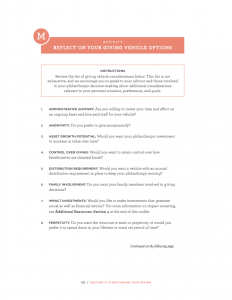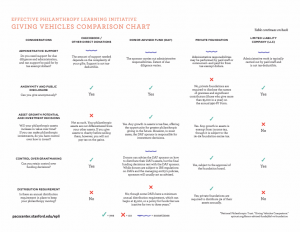Structuring Your Giving
-
4.1 Determine your philanthropy budget
It is a personal decision to determine how much to give to your focus areas compared to reserving resources for you and your family’s present and future needs. This toolkit intends to focus on proactive giving in the focus areas you identified in Section 1. The activities below will help you categorize and distribute your contributions into three buckets:
- PROACTIVE GIVING, which includes contributions to organizations working on your selected issues
- REACTIVE GIVING, which includes contributions to personal requests from family and friends to support their selected issue areas
- EMERGENCY GIVING, which includes contributions to disaster and emergency relief funds, or dire situations that emerge from unexpected policy changes
Additionally, there are two approaches you can take to arrive at your total philanthropy budget: you can use your previous contributions to inform your future giving related to the values and issues you identified in Section 1: Finding Your Focus Areas. Alternately, you may prefer to start with a clean slate to determine how much to give. Regardless of the approach you choose, you may want to discuss your overall financial plan with your advisor before determining your final philanthropy budget and giving cycles.
ACTIVITY J: RECOUNT YOUR CONTRIBUTIONS
This activity is for those who have made previous contributions to their selected issues.
Recount your previous contributions to understand your giving distribution across your selected issues and the total amount allocated. Consider adjustments to make your giving more proactive.
Skip ahead to Activities K and L if you prefer to start from a clean slate with your future giving plans.
Suggested printing instructions: Legal-size, landscape, single-sided
ACTIVITY K: SET YOUR TOTAL PHILANTHROPY BUDGET
Review the questions in Activity K either on your own or with the support of your advisor, and jot down your thoughts. You do not have to answer all the questions.
Suggested printing instructions: Letter-size, portrait, double-sided
ACTIVITY L: ALLOCATE YOUR TOTAL PHILANTHROPY BUDGET
Determine how you would like to allocate your total philanthropy budget across your focus areas and giving buckets (i.e., proactive giving, reactive giving, and emergency giving) using the Budget Coins. Adjust your philanthropic allocations until they feel right to you.
Suggested printing instructions: Legal-size, landscape, single-sided
EPLI BUDGET COINS
We developed EPLI Budget Coins to help you allocate your budget across multiple focus areas.
Suggested printing instructions: Letter-size, portrait, single-sided
-
4.2 Select your giving vehicles
A philanthropic giving vehicle provides a structure for you to carry out your giving. This section will help you identify which giving vehicles are best suited to your personal, financial, and philanthropic preferences. Keep in mind that you can achieve your philanthropic objectives through any vehicle; the goal here is to ensure that you select the vehicle or combination of vehicles that best aligns with your broader needs.
Most common giving vehiclesCHECKBOOK OR OTHER DIRECT CONTRIBUTIONS
The most common way to make a gift is by writing a check or using a credit card. Such contributions qualify for a same-year tax deduction. You can also qualify for tax deductions when you donate long-term appreciated non-cash assets (e.g., stocks) directly to charitable organizations or foundations. You may want to have a discussion with your advisor about the assets best suited to your goals.
DONOR ADVISED FUNDS
A donor advised fund (DAF) is, in effect, a philanthropic investment account. You can contribute cash, securities, or appreciated non-cash assets to your account and qualify for a same-year tax deduction (equal to the deduction for giving to any public charity).
DAFs are managed by nonprofit entities, community foundations, and the charitable arms of for-profit financial service providers. Each managing entity has different minimum contributions, gifts, investment programs, and fees. DAFs within community foundations offer a local focus, with knowledgeable staff and donor education opportunities to enable place-based giving (conducting some of your giving beyond the local area is also typically allowed). DAFs at for-profit financial service providers and other independent sponsoring organizations offer the opportunity for a broader focus, as well as financial and investment expertise.
While DAFs allow you to postpone decisions about specific contributions (i.e., the nonprofit organizations receiving your gifts), the contributions to the managing entity are irrevocably given to the charitable purpose (though you can move them from one managing entity to another). Once this contribution is made, you can advise, but not direct, the managing entity to support specific recipients. Typically they will do so—as long as those recipients comply with IRS regulations on DAFs and any additional guidelines the entity may set (and should share with you upfront).
PRIVATE FOUNDATIONS
Private foundations are tax-exempt nonprofit organizations that must pay out at least 5% of their assets each year in the form of grants and operating charitable activities. These organizations are also required by the IRS to file an annual Form 990-PF—a publicly available document that describes the foundation’s grants, investments, and expenses. You will receive a tax deduction when you transfer assets to a private foundation. A foundation must have a board of directors, typically of three or more persons. Depending on the size and activity of the foundation, paid staff may be necessary for management and administrative work. Some donors want their foundation to exist in perpetuity, while others may wish to spend down all the foundation’s assets within their lifetime or over some set period of time.
Operating foundations, a subset of private foundations, primarily conduct their own charitable programs; some also make grants. Operating foundations have a legal classification under the IRS and are required to spend 85% of their assets each year on charitable activities.
LIMITED LIABILITY COMPANIES
Limited liability companies, or LLCs, are business structures that limit donors’ personal liability against lawsuits. LLCs are pass-through entities that can also function as philanthropic vehicles. As with business LLCs, income and charitable tax attributes flow through to its member(s). Contributions to the LLC itself are not deductible for charitable income tax purposes; it is only when the LLC makes a charitable contribution that its member(s) are eligible for a tax deduction. LLCs do not have annual distribution or public disclosure requirements.
Charitable giving through estate planning
These vehicles allow donors to benefit both non-charitable beneficiaries (i.e., the donor, the donor’s children, etc.) as well as charitable organizations. These trusts can be created during the donor’s lifetime or in a will.
CHARITABLE REMAINDER TRUSTS
Charitable remainder trusts are irrevocable trusts from which there are payouts for life or a period of up to twenty years to a non-charitable beneficiary, after which one or more charities receive whatever is left (the “remainder”). For example, the trust may provide that the donor (or the donor and spouse, or any person named) gets the income for life, or for several years, and that everything left goes to a specified charity. Only the remainder is treated as a charitable gift; this amount is tax deductible when you create the trust.
CHARITABLE LEAD TRUSTS
Charitable lead trusts reverse the charitable remainder trust—that is, the charities get paid out first. A charitable lead trust is an irrevocable trust that makes at least annual payments to designated charities for a set period of time. After that period, the trust ends and the balance passes to designated non-charitable beneficiaries, such as family members or others.
BEQUESTS
Bequests are gifts from your assets—whether they be a transfer of cash, securities, or other property—made through your estate plan or will. You can make a bequest to designated charitable organizations by including language in your will or living trust. You can also designate an organization as a beneficiary of your retirement account or life insurance policy.
ACTIVITY M: REFLECT ON CONSIDERATIONS FOR CHOOSING A GIVING VEHICLE
Review the list of giving vehicle considerations below. This list is not exhaustive, and we encourage you to speak to your advisor and those involved in your philanthropic decision-making about additional considerations relevant to your personal situation, preferences, and goals.
Suggested printing instructions: Legal-size, landscape, single-sided
Review the list of giving vehicle considerations below. This list is not exhaustive, and we encourage you to speak to your advisor and those involved in your philanthropic decision-making about additional considerations relevant to your personal situation, preferences, and goals.
- ADMINISTRATIVE SUPPORT: Are you willing to invest your time and effort on an ongoing basis and hire paid staff for your vehicle?
- ANONYMITY: Do you prefer to give anonymously?
- ASSET GROWTH POTENTIAL: Would you want your philanthropic investment to increase in value over time?
- CONTROL OVER GIVING: Would you want to retain control over how beneficiaries use donated funds?
- DISTRIBUTION REQUIREMENT: Would you want a vehicle with an annual distribution requirement in place to keep your philanthropy moving?
- FAMILY INVOLVEMENT: Do you want your family members involved in giving decisions?
- IMPACT INVESTMENTS: Would you like to make investments that generate social as well as financial returns? For more information on impact investing, see Additional Resources: Section 4 at the end of this toolkit.
- PERPETUITY: Do you want the structure to exist in perpetuity or would you prefer it to spend down in your lifetime or some set period of time?
-
POLITICAL CONTRIBUTIONS: Do you want to make political donations and engage in lobbying? Direct political contributions are not tax-deductible, though some lobbying and advocacy can be, depending on a number of factors. Seek further professional advice if politics is a priority issue for you.
10. PUBLIC DISCLOSURE: Are you willing to submit separate tax records that will be available to the public?
11. TAX IMPLICATIONS: Are tax implications important to your choice of vehicle? To understand how different taxes may be affected by your giving, see Additional Resources: Section 4 at the end of this toolkit.
RESOURCE: EPLI GIVING VEHICLE COMPARISON CHART
Review the EPLI Giving Vehicle Comparison Chart to determine how your preferences align with the different giving vehicles available.
EPLI has highlighted the four most common giving vehicles that also allow you to give during your lifetime: checkbook/ other direct donations, donor advised funds (DAFs), private foundations, and limited liability companies (LLCs). These vehicles in particular allow for more flexibility in your philanthropy. We encourage you to discuss these options with a trusted advisor.
Suggested printing instructions: Letter-size, landscape, single-sided







